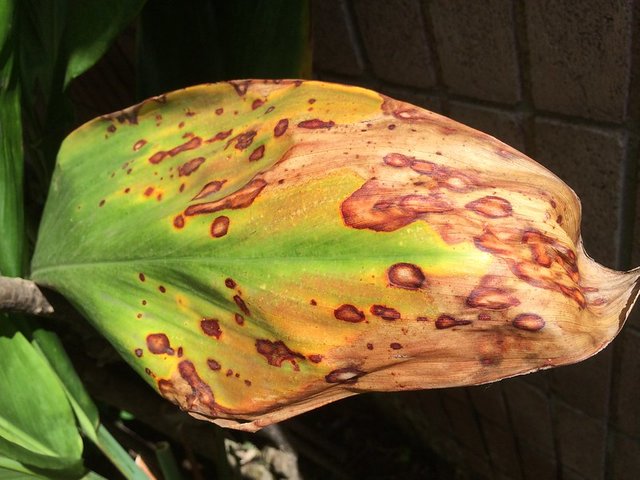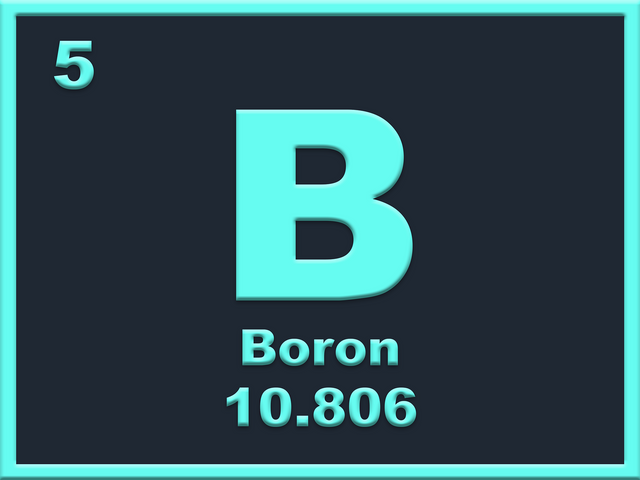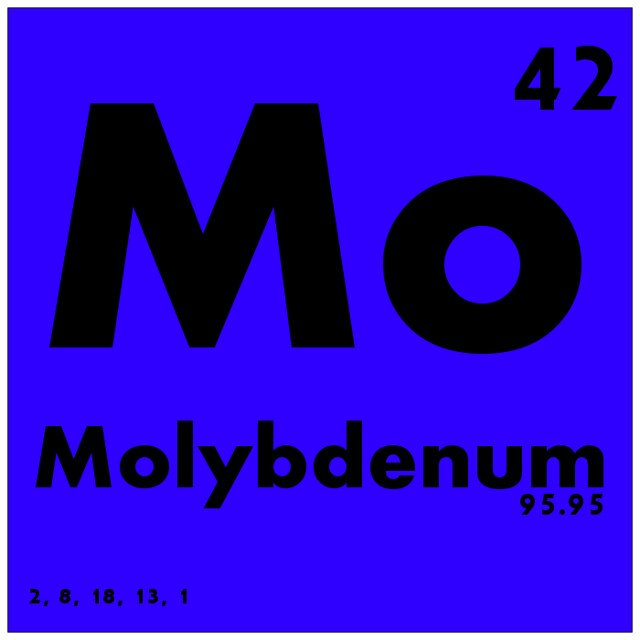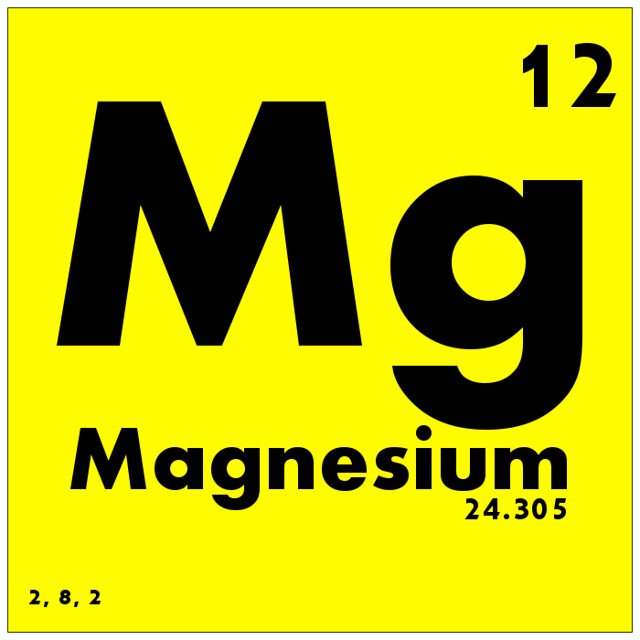Permaculture - Boron, Molybdenum, Copper, Magnesium (Lesson 10)
Intro
In the previous lesson, we already mentioned three of the most important nutrients for all plants. It's so-called "NPK", which means Nitrogen, Phosphorus and Potassium (to read about them, click here ). Obviously, we can find any other nutrients in the soil and partially, in the plants we eat. Even though the list which I will present to you today contains less important ingredients, completely ignoring them would be very harmful to our crops.
BORON
One of the most deficit component of european soils. In example, in Poland where I come from, 80% of the country's territory is with low boron content. Light and very light soils are particularly sensitive to deficiencies.
Boron usually does not accumulate in the soil, with water being washed out annually about 2.5 grams for every 100 m2 of the garden. The demand is from 0.5 to 6 grams for every 100 m2 of crops and depends on the type of crops grown.
It is required in the greatest amounts by cabbages and beetroot, legumes, rapeseed and sunflower, and in perennial plants - pear trees, apple trees, plum trees, and walnuts. In the smallest amounts, it is needed for cereals, peaches, strawberries, or citrus.
Boron excess can be caused by contamination of soil with detergents, or too many marine or oceanic ingredients (for example, as compost components), and long droughts.
Boron helps in the transport of sugar in the plant, builds tissue, and affects the production of pollen. Deficiencies have a negative effect on the plant's frost resistance and susceptibility to diseases.
boron deficiencies:
- limiting the growth of the whole plant
- in severe deficiency, death of growth tips, shoots, and roots
- thickening of young leaves and stems, their high brittleness
- premature dying and corking of seeds
- graying and sponging of the roots of the plant
- with sugar beet: leads to heartleaf rot and beetroot dry rot. Strong deformation of the leaves, growth of the leaf blade, with time-twisting, browning, and elongation of the leaves. At a later stage, dry root rot and overproduction of small leaf buds.
- in oilseed rape: chlorosis on young leaves, curling edges of older leaves, red-purple discoloration. Plant stunting, weaker flowering, premature flower fall.
- for potatoes: stunted tubers, cracking, shoot tip dieback, deformation of young leaves, increased brittleness. Increased risk of potato scab disease.
- with maize: shortening of the internodes, stunting of the cobs, irregular rows of grains, grains often not grown.
- horse bean: distortion of the growth cone in the green bud phase, chlorosis and necrosis of the upper leaves, lots of side shoots, no further growth of the main shoot.
Response:
- First, adjust the soil pH with limestone or sulfur. Boron is available for the plants at a pH in the range of 4.0 - 7.0, but the highest bioavailability is in the range of 5.0-6.0.
- If this is not enough, use Borax (allowed in organic farming. Time and dose specified on the package, depending on the plants in the garden). You can also use a universal dose of 10 grams for every 100 m2 in early spring or fall.
- When fertilizing the garden with compost or manure, you also introduce boron into the soil. For manure, the average value is 5.3 mg for each kilogram of fertilizer
- boron can also be introduced into the soil with basalt flour, algae, or mineral flour mixed with compost (see: mineral fertilizers, one of the previous lessons I published)
- an indicator of a large amount of boron in the soil is the salsola plant. In small gardens, one of the possibilities is to mix the garden soil with soil taken from areas with large clusters of these plants.
Boron excess:
- limited fruit setting and distortion
- premature maturation of the plant
- necrosis and chlorosis of leaves
Response:
The excess boron will be leached from the soil over time. No other treatments are used.
MOLYBDENUM
After boron and copper, the third micronutrient that is most often lacking. Molybdenum deficiency usually occurs in acidic, strongly washed-out soils. Soils with an overdose of limestone and those with too much iron (blocking digestibility) are also problematic. Greater demand for molybdenum is shown by alfalfa, clover, tomatoes, beans, cabbages, lettuce, spinach, and rapeseed.
Molybdenum is responsible for the binding of atmospheric nitrogen, facilitates the absorption of iron and phosphorus, increases the content of carotene and vitamins in the plant, its resistance to diseases and drought, by increasing the ability to retain water in tissues.
Molybdenum deficiencies:
- inhibition of plant growth
- tip leaves chirping
- changes in the color of the leaves (from light green to yellow or brown) with dead spots, no leaf development in the later stages
- often asymptomatic, only significantly reducing the number of yields
- legumes: poor seed binding, impaired nitrogen uptake
- cabbages: leaf curl, wrinkled tips, scattering of smaller roses
Response:
- in the first place, the pH of the soil should be raised with calcium to a satisfactory level. Molybdenum bioavailability is from pH 4.5, but its highest bioavailability starts from pH 6.0. There is no upper limit.
- green fertilizers that extract this microelement from the deeper layers of the soil are primarily vetch and alfalfa
- molybdenum is introduced into the soil along with fertilization with compost and manure. Averaged amount per kilogram of cows' manure is 0.4 mg
- Molybdenum is contained in basalt flour and other mineral fertilizers
- The use of sodium molybdate is allowed in organic farming. Mix 10 g of fertilizer with 5 kg of sand. Use 0.5 kg for every 100 m2 of the garden not more than once in 10 years.
Molybdenum excess:
- an overdose of molybdenum, even two to three times, is not a threat to plants, but it can be harmful to the human who consumes them
- too much molybdenum in the diet results in joint pain, deterioration of bones and teeth, impaired absorption of other ingredients, such as iron, calcium, fluorine, or copper
COPPER
Deficiencies are mainly found in dry, basalt, sandy, coastal and acidic soils. Sheep are a good indicator of the amount of copper in the soil. With a deficiency of this mineral, their fleece darkens over time.
Mainly grains are characterized by a high demand for copper. Copper is involved in the transformation of nitrogen compounds in the plant (protein biosynthesis), in the processes of photosynthesis, respiration, carbohydrate transport, and metabolism of cell membranes. It is a component of enzymes and participates in the synthesis of growth hormones.
In traditional agriculture, it is used to prepare the antifungal mixtures.
Copper deficiencies:
- faster spoilage of the harvested vegetables
- light green or yellow-green discoloration of the leaves, sometimes curling
- drying of the tips of the youngest leaves that hang twisted
- no seeds are formed
- cracking and flaking of the bark of fruit trees
- often disturbances in flower and fruit set
- for cereals, a significant drop in yield, low stiffness of the stalk
- infertility is possible with farm animals
Response:
- First of all, make sure that the soil pH is correct (copper can be absorbed in the soils with pH 4.5 and more, reaches the optimum in the range of 5.5-6.0, and then drops slightly and remains at an average level up to the soil strongly alkaline) - make sure that the garden does not contain too much phosphorus (blocks the absorption of copper)
- copper is found in algae products, mineral fertilizers, manure (on average 5 mg per kilogram of manure), and compost. Many plants extract it from the deeper layers of the soil, so green fertilizers can be used (see: lesson with the phitosanitary plants and green fertilizers)
- every 5-7 years, copper sulfate can be used in a dose of 10g for every 100m2
- burying copper items, recommended by some people, is a fairly common myth. Copper is practically immobile in the soil, so such treatments are not recommended.
- Watering the garden with water in which the copper object has been soaked is effective as a preventive measure against shortages, provided that this method is used regularly (you can, for example, have a copper watering can. Unfortunately, this is quite an expensive investment)
Copper excess:
- faster spoilage of the harvested vegetables
- inhibition of the growth of roots and shoots
- chlorosis
- necrosis
Response:
- increasing the amount of phosphorus in the soil will reduce the absorption of copper by plants
MAGNESIUM
In soil, magnesium occurs mainly as silicate and aluminosilicate minerals. In general, the magnesium content in the soil is between 0.5 and 5 g per kg of soil. An alarming and demanding situation is when this level drops to 0.03 g per kilogram on very light soil - 0.08 g per kilogram on heavy soil.
Magnesium deficiency most often occurs in sandy soils, least often in clay, loam, and loess soils. Increased risk of deficiencies occurs in acidic soils and after prolonged downpours. This is due to the fact that magnesium is a mobile element that is easily leached into the soil.
The highest demand for magnesium is shown by cereals and they are also the most effective natural indicator that will alert us in time that this nutrient is missing in the soil. Early, in the 2-3 leaf stage, clusters of chlorophyll along the veins on the brightened leaf can be observed ("leaf pearls", as they resemble a string of pearls). With long time magnesium deficiency, lower leaves turn brown and wither, younger leaves are narrow and tubular. The plant turns yellow, but the pearl shape is no longer visible. If there is still no reaction, the leaves turn brown and die.
The content of magnesium in the soil significantly affects the quantity and quality of crops. It is the fifth most important soil mineral. It is responsible for building chlorophyll, so it significantly influences photosynthesis. It is also responsible for the absorption of nitrogen and phosphorus, takes part in all metabolic processes, and plays a role in the processes of respiration, the synthesis of sugars, proteins, fats, vitamins, and many colorants. With a magnesium deficiency, the plant is more vulnerable to diseases and pest attacks.
Magnesium deficiencies:
- older leaves turn yellow and with time whitish stripes are formed between the leaf veins and on its edges (chlorosis). Younger leaves are attacked much later, not responding to time.
- faster drying of plants on the sun exposure
- legumes: discoloration of the nervous tissue from the tips on the lower leaves. The nerves stay bright green.
- limiting the growth of the root system
Response:
- first, make sure that the potassium content in the soil is not too high. Potassium in too large amounts blocks the absorption of magnesium.
- make sure that the pH of the soil is correct. Although magnesium is absorbed already in soils with an acidity coefficient of 4.0, the highest bioavailability is at pH 6.0-8.0. To increase the pH, you can add dolomite (it will increase the pH thanks to the limestone and at the same time it will add magnesium)
- magnesium is found in some salt deposits, in talc, wood ash, olivine, serpentine, stearates
- can be introduced with some mineral fertilizers
- lifting up from the deeper layers of soil with the help of some green fertilizers (see: lesson about green fertilizers)
- introduced with compost, especially containing algae products, and in manure, preferably cow manure (the average content in cow manure is 1.1 g of magnesium for each kilogram of manure) and guano, especially turkey manure
- can be introduced into the soil along with lime using dolomite. Basalt dust is also perfect for tropical soils.
Magnesium excess:
- it happens extremely rarely, only as a result of human errors during fertilization
- with an excess of magnesium in the soil, the absorption of calcium from the soil decreases. Potassium intake can also be impaired
All my lessons are shared totally for free with a CC-0 license (which means you can copy my text and share it wherever you want to, without the need to mark me as an author). I hope it will bring you joy.
Previous lessons can be read here:
Fertilizers
2 - types of manure and when to use it
3 - Compost. Basics
4 - advanced composting
Soil and minerals
9 - Nitrogen, Phosphorus, Potassium
Thank you for reading,
@papi.mati





Good work.
thank you
Wow! You are doing really great. These lessons are very detailed and it's interesting to know.
I like planting trees and couple of years ago, I was looking for this information on internet but couldn't really get all of them in one place or from one source. I believe your posts are quite handy as it contains all the information.
Thank you ftz. I promise to do my best to share my knowledge with other users of the community.
Great.